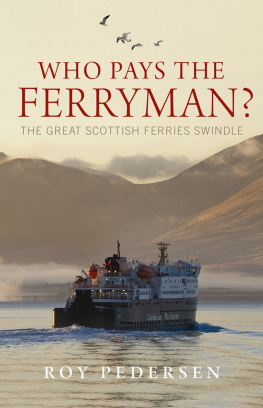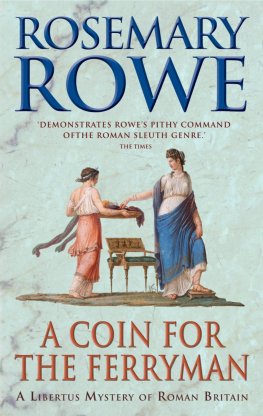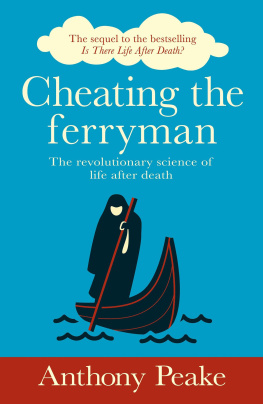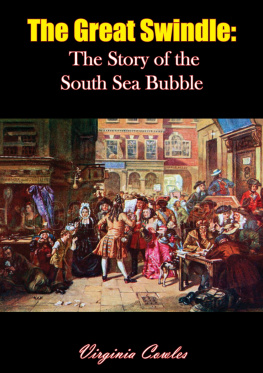WHO PAYS THE FERRYMAN?
Born of a maritime family, Roy Pedersens former career with development agencies Highlands and Islands Development Board and Highlands and Islands Enterprise, where he pioneered numerous innovative and successful ventures, has given him a matchless insight into world shipping trends and into the economic and social conditions of the Highlands and Islands. He is now an author and the proprietor of a cutting-edge consultancy.
OTHER BOOKS BY THE SAME AUTHOR
One Europe A Hundred Nations
Loch Ness with Jacobite A History of Cruising on Loch Ness
Pentland Hero The Saga of the Orkney Short Sea Crossing
George Bellairs The Littlejohn Casebook: The 1940s
Fiction
Dalmannoch The Affair of Brother Richard
Sweetheart Murder

This eBook edition published in 2013 by
Birlinn Limited
West Newington House
Newington Road
Edinburgh
EH9 1QS
www.birlinn.co.uk
Copyright Roy Pedersen 2013
Foreword copyright Professor Alfred Baird 2013
The moral right of Roy Pedersen to be identified as the author of this work has been asserted by him in accordance with the Copyright, Designs and Patents Act 1988
All rights reserved.
No part of this publication may be reproduced, stored or transmitted in any form without the express written permission of the publisher.
ISBN: 978 1 78027 122 4
eBook ISBN: 978-0-85790-603-8
British Library Cataloguing-in-Publication Data
A catalogue record for this book is available from the British Library
This book is dedicated to the memory of my father.
He opened my eyes to the world of shipping and boats.
His most precious gift: he taught me to think for myself.
LIST OF ILLUSTRATIONS
P&O Ferries 40-knot catamaran Express.
Western Ferries Sound of Shuna.
Highland Councils MV Corran.
CalMacs Clansman departing from Castlebay, Barra.
CalMacs Loch Alainn at Eriskay slipway.
Daggri and the simple lock-on Norwegian style link-span terminal.
Orkney Ferries North Isles ferry Varagen at Kirkwall.
NorthLinks 30-million Hamnavoe at the 20-million Scrabster terminal.
Pentland Ferries 7-million Pentalina berthing at the 2-million Gills Bay terminal.
MacCallum Ormes Dunara Castle in the Sound of Iona.
St Clair, the last steam ship built for the North of Scotland Orkney and Shetland SN Co.
Paddle steamer Waverley at Iona.
Derrick-loading motor vessel Locheil at West Loch Tarbert.
Firth of Clyde side-loading car ferry Arran.
Western Ferries revolutionary drive-through, Sound of Jura.
Glenachulish; Scotlands last turntable ferry operating between Glenelg and Kylerhea (Skye).
The go-anywhere 16-metre catamaran, Orca III, operated by Atlantic Marine Services.
MossHorten shuttle: a typical Norwegian pendelferje.
SeaLink Kangaroo Island 16-knot, 378-passenger, 55-car catamaran ferry Sealion 2000.
Foveaux Express arriving at Oban, the tiny capital of New Zealands Stewart Island.
The first of ten new 49-metre Sea Transport Corporation 50-car ferries for the Philippines.
The Author and Professor Alf Baird being presented with best paper prize at the May 2012 STAR Conference.
FOREWORD
By Alfred Baird, Professor of Maritime Business, Edinburgh Napier University
This book is a wonderful mix of history, economics, commercial success and failure, the latter so often nowadays associated with public sector (mis)management. Roy Pedersen provides an invaluable contribution to the ongoing story of Scotlands ferry industry. As a former officer with Highlands and Islands Enterprise and its predecessors, Roy has developed over the last 40 years and more an eye for what is good and what is bad about ferry services.
The historical perspective is provided for readers so that they might better understand how we have got to where we are today. We should not forget that Roy, as the inventor of Road Equivalent Tariff (RET), is well acquainted with the economics of ferry services. And here we see in full technicolor the interception of immense and ever-increasing subsidies for publicly run ferry operations in Scotland.
So, who intercepts these economic rents? Well, the evidence presented tells us that the key stakeholders, namely the public operators, trade union members, local authorities, port trusts, and other vested interests intercept most of the subsidy long before what is left reaches the user. This leaves little for the benefit of users in terms. A case in point is the immense subsidy paid to Serco NorthLink to run its Pentland Firth service, only for users to express surprise when they find out that lower rates and a quicker, more frequent, passage can be obtained by using the unsubsidised Pentland Ferries service.
Roy Pedersen illustrates very clearly the difference in the competence of private ferry operators, most notably Western Ferries and Pentland Ferries, compared with the extraordinary inefficiencies of state-managed ferry operations and assets. The tragic consequence of this gross mismanagement brings him back to his former role at HIE in helping island and remote communities improve their accessibility and through that to bring about a better chance to compete in whatever market. His identification of and preference for short ferry routes, where operators can offer higher levels of frequency at lower cost, and hence lower subsidy (or none), and ensure better accessibility, is compelling. The evidence on this from Western Ferries, Pentland Ferries and countless overseas operators is overwhelming. Yet the state, for the most part, continues to specify and is paying over the odds for the wrong routes and the wrong designs of ships and port facilities.
The cause is multi-facteted. Well-meaning civil servants responsible for ferries start with limited knowledge of the sector, and take their advice from the vested interests. Ministers have even less knowledge, so take their advice from the officials. State-owned ferry entities are staffed by individuals who have limited commercial ferry expertise, or are from a military background where over-spending and over-specifying has been the norm.
If Roy Pedersen demonstrates anything, it is that the state should not be buying ferries, never mind operating them. The mistakes are endemic and long-term. A ship lasts 25 years or more, which implies that an expensive and inefficient ship will carry with it a significant financial burden for the same period.
The ongoing ferry fleet and port procurement activities sponsored by the state make the Edinburgh Tram debacle look like a very good deal indeed. And PFI is not dead; it lives on, not least in the newly ordered Stornoway ferry. And so long as a budget is made available for ferries, this tragedy will continue to be acted out, and vested interests will prevail.
Reform? How to do it? Roy Pedersen illustrates what can be done. The rather obvious solution is to shift to shorter routes, using less expensive vessels, which in turn allows for greater frequency, higher capacity and rising demand, and to leave ship procurement to people who at least understand what they are doing.












